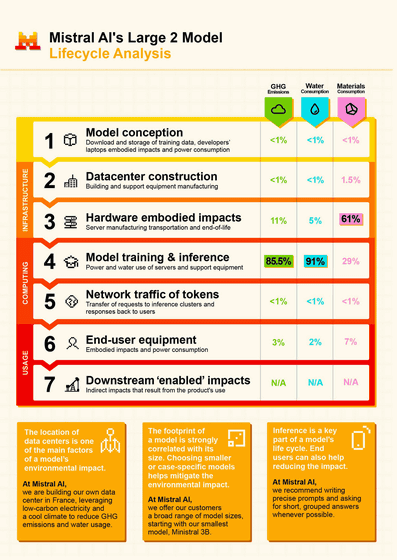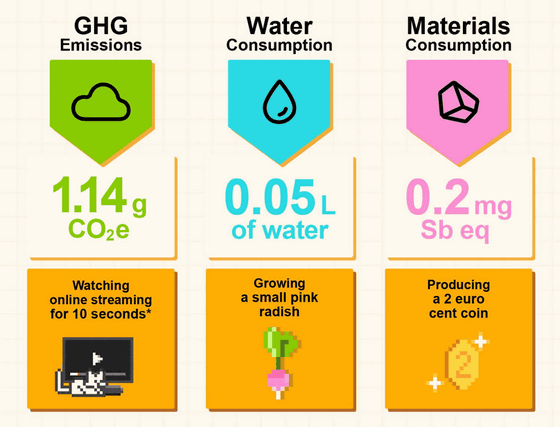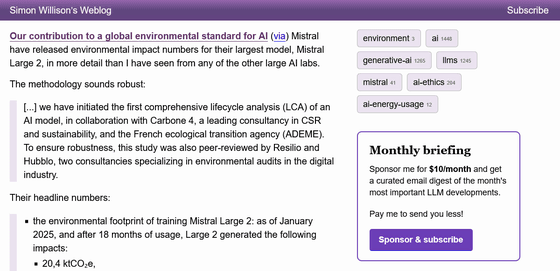Mistral AI reveals details of how AI models impact the environment, including greenhouse gases, water, and energy

On July 22, 2025, Mistral AI announced the results of a comprehensive study on the environmental impact of AI. The initiative aims to quantitatively analyze the environmental footprint of AI and set new standards for greater transparency across the industry. It was conducted in collaboration with French consultancy
Our contribution to a global environmental standard for AI | Mistral AI
https://mistral.ai/news/our-contribution-to-a-global-environmental-standard-for-ai
The study focuses on Mistral AI's largest model, Mistral Large 2. According to the report, over the 18 months of use up to January 2025, the environmental impacts of the model's training phase included greenhouse gas emissions of 20.4kt CO2 equivalent, water consumption of 281,000m3 , and an index of resource depletion of 660kg antimony equivalent.

On the other hand, the additional impact of using the AI assistant 'Le Chat' to generate 400 tokens, which is about one page of text, was 1.14g of greenhouse gas emissions per response. This is equivalent to an American user watching 10 seconds of video streaming. It also consumed about 50mL of water, which is just equivalent to growing one small radish. And the impact on resource depletion was the same as producing one 2 euro coin, about 0.2mg of antimony.

Looking at the entire life cycle, the majority of the environmental impact was concentrated in certain stages: 85.5% of greenhouse gas emissions and 91% of water consumption were attributable to the electricity and water use of servers and related equipment in 'model training and inference.' Meanwhile, in terms of material consumption, the 'embodied impacts of hardware,' including the manufacturing, transportation, and disposal of servers, accounted for 61% of the total, showing the large environmental impact of AI infrastructure itself.
Mistral AI concluded from this study that there is a strong correlation between model size and environmental footprint, and emphasized that users can reduce their environmental impact by choosing a model size that is appropriate for their application. Mistral AI advocates that AI companies report their environmental impact in a standardized framework and that users can use AI in a more efficient way. It will continue to update its environmental impact report in the future and contribute to discussions on the establishment of international standards.
Blogger and developer Simon Wilson praised the Mistral AI announcement in his blog, but pointed out some challenges:
Our contribution to a global environmental standard for AI
https://simonwillison.net/2025/Jul/22/mistral-environmental-standard/

Wilson praised Mistral AI for publishing more detailed figures on the environmental impact of Mistral Large 2 than any other major AI lab, and said its methodology is reliable because it involved French government agencies and expert consultants and was peer-reviewed.
On the other hand, Wilson is unhappy that the figures for the environmental impact of 'model training and inference' have been combined. In discussions of AI energy consumption, the breakdown of training and inference costs is always an important point of contention, so he pointed out that this data should have been shown separately. Furthermore, he said that it is difficult to understand the specific scale of greenhouse gas emissions of 20.4 kt, and that it should have been explained in context.
Related Posts:







